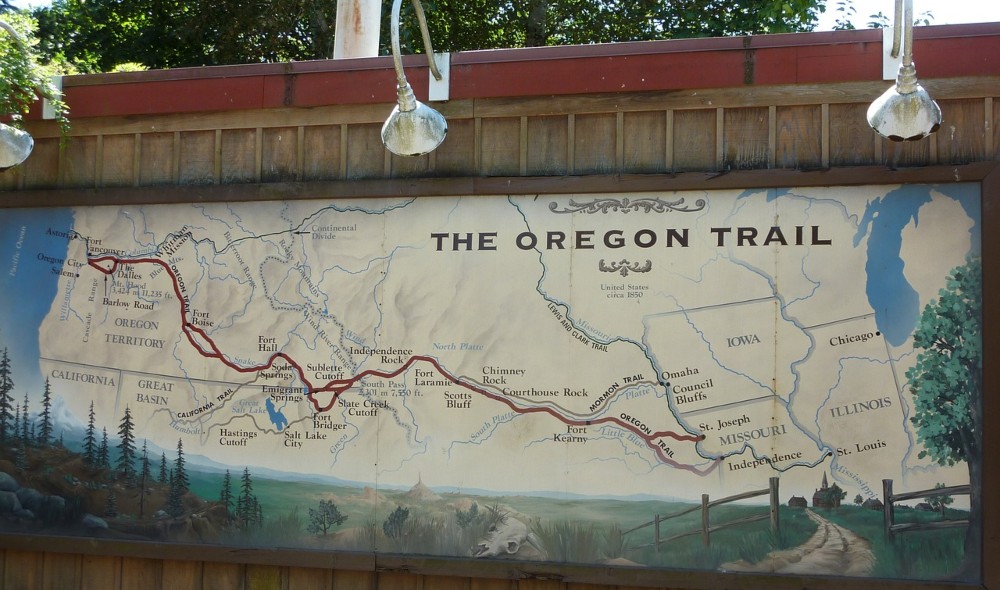Moving west was Thomas Jefferson’s suggestion for restless citizens, followed by the real-life drama of Americans dreaming, struggling, and exploring across the vast “new” North American continent.
Fur trappers came first, followed by explorers, missionaries, and good folks on foot, horseback, and aboard a wide selection of wheeled wagons. At first animal and Native trails were trudged, later branching onto the banks of rivers and streams flowing from the Rocky Mountains and lesser ranges.
Among the fur-seekers were employees of John Jacob Astor, American entrepreneur and dreamer. In 1811, a few years after the great Lewis & Clark adventure (1804-06), Wilson Price Hunt followed the Snake River by foot, having given up the use of boats after nearly drowning in wild waters. After the 1812 discovery of the relatively low South Pass through the Rockies, others saw the possibility of wagons traversing the Great Divide. Someone observed that our Eastern U.S. was settled by means of waterways; our West by means of wagon roads.
The famed Oregon Trail soon came into play in fact, fiction, and myth. In summer the trail was parched and dusty, and it could be a desolate sight: animal skeletons, broken wagon wheels, abandoned furniture, cracked mirrors, children’s toys, and crude gravesites. Winter travel was often a battle against mudflow, horizontal rainstorms, blizzard, moonless nights, and rare but terrifying Native raids.
The first recorded Oregon Trail attempt with a wagon train occurred in April, 1830. Ten wagons, drawn by five mules each, 81 men, assorted cattle, and one milk cow left St. Louis, Missouri. After six months the men, wagons, and wretched cow returned with pelts and vivid stories of the trail they had blazed only so far as Wind River, at the eastern slope of the Rocky Mountains. That 1830 adventure inspired Captain B.L.E. Bonneville of the U.S. Army to take a leave of absence to lead the first wagons, 20, across South Pass into the Oregon Country.
News of Bonneville’s trip caused a stampede. Missionary Dr. Marcus Whitman and his bride Narcissa, along with Henry and Eliza Spalding, William Gray, and a Nez Perce guide, started west. They picked up a young hiker named Miles Goodyear. This unlikely group encountered Mountain Man Joe Meek and an unruly gang at the Green River Rendezvous, an annual event held by fur traders and trappers to buy and sell furs.
This unexpected meeting was so wild that the Whitman party thought it was under attack. Natives and trappers staged a noisy demonstration of games, horsemanship, and a mock battle. In response, Narcissa Whitman sang a song, “Watchman Tell Us Of The Night.” At this point the “beasts” were tamed by the “beauty.”
Independence, Missouri eventually became the principal gathering place for large wagon trains embarking on the Oregon and Santa Fe Trails. In fact, in May of 1843, almost 1,000 men, women and children gathered at Fitzhugh’s Mill near Independence (Harry Truman’s later hometown) to undertake a trek that would alter the history of America.
These and other families followed the now famous Oregon Trail, observing and immortalizing natural sign-posts such as Court House Rock, Chimney Rock, Scotts Bluff, and Laramie Peak. Rivers called Sweetwater, Green, Bear, and the great Snake entered the vocabulary and pages of American history.
Most westward travellers aimed for what was called Oregon, and their principal goal was the Willamette Valley, south of today’s Portland, Oregon. That former inland sea, filled with rich volcanic soil and a favorite growing and hunting ground of Natives for over 10,000 years, remains a prime farming and fruit-growing slice of the West, especially wine grapes.
The raucous, frightening and seemingly endless ordeal of the Oregon Trail opened the Far West to the world. Jefferson’s dream and admonition had come true.
Discover more from Post Alley
Subscribe to get the latest posts sent to your email.

Speaking of Thomas Jefferson, how about an honest accounting of why he & other Founding Fathers created the *racist* electoral college; i.e., to consolidate their own nefarious power by counting their slaves as 3/5 of a person. Pathetic! Funny how we weren’t taught the truth in school about our Feral Founding Fathers!